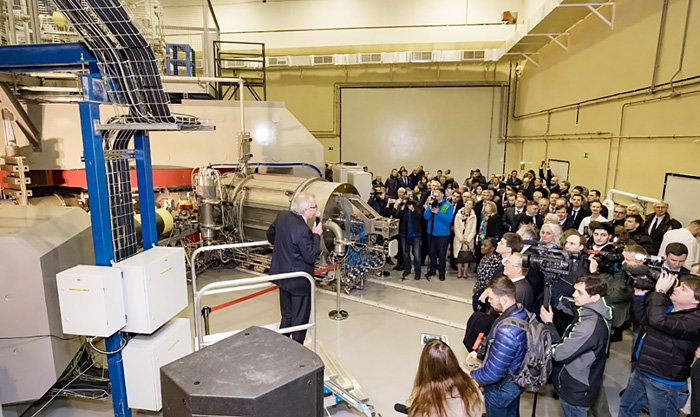
Electronic english version since 2022 |
The newspaper was founded in November 1957
| |
Projects of the 21st century
The DC-280 cyclotron of the Factory of Superheavy Elements
The discovery of new superheavy elements with atomic numbers 114-118 became one of the most outstanding scientific achievements of the past decade. Priority experiments were implemented in JINR at the accelerator complex U-400 of the Flerov Laboratory of Nuclear Reactions. The synthesis was carried out in complete fusion reactions involving the doubly magic nucleus 48Ca and neutron-rich actinide nuclei (242,244Pu, 243Am, 249Cm, 249Bk, 249Cf). The occurrence of the island of stability was confirmed, the last period of the Mendeleev's periodic table was completed.
At present, one of the main issues in the synthesis of new elements is: can elements with atomic numbers greater than 118 be created? The direct synthesis of elements with Z>118 in fusion reactions is related to the transition to bombarding nuclei heavier than 48Ca, since the possibilities of producing target material in nuclear reactors are limited because of the production of Cf isotopes. The production cross sections (probability of production) of nuclei with Z=120 in the 248Cm + 54Cr reaction and nuclei with Z=119 in the 249Bk + 50Ti reaction are expected to be about 10-20 times lower than that of the isotopes of SHE in experiments on the synthesis of elements 114 and 115 in reactions with 48Ca. For a more detailed study of the nuclear-physical and chemical properties of SHE, it is also necessary to significantly increase the efficiency of experiments. For this purpose, the SHE Factory was developed.
The construction of the DC-280 cyclotron was completed at the beginning of 2019. In parallel, the first physical facility of the SHE Factory was constructed - a novel gas-filled separator GFS-2. The Superheavy Element Factory was officially commissioned on 25 March 2019.
Since the launch of the DC-280 cyclotron, it has operated for more than 14 000 hours. To date, the parameters of the cyclotron beams are close to the design ones, beams with a power of up to 2.5 kW have been obtained, for example, 40Ar+7, 48Ca+10 beams, with the intensities of 10.4 pµA and 7.8 pµA, respectively. Also, work on the commissioning of a "flat-top" resonance system continues. In particular, experiments on the impact of the operation of this system on the accelerated beam of charged particles are underway.

Official opening of the DC-280 cyclotron.
Since December 2020, a range of experiments on the synthesis of element 114 (flerovium) in the 242Pu + 48Ca reaction, element 115 (moscovium) in the 243Am + 48Ca reaction and element 112 (copernicium) in the 238U + 48Ca reaction have been carried out at the GFS-2 facility. In these experiments, 128 events of the synthesis of element 114, 94 events of element 115 and 16 events of element 112 have been acquired.
In addition to experiments on the synthesis of superheavy elements, work is underway to gain high intensities of titanium and chromium ions for experiments on the synthesis of elements 119 and 120. To date, 48Ti with the intensity of 1 pµA and 52Cr with the intensity of 2.6 pµA have been obtained.
At the end of 2021, the installation and commissioning of the gas-filled separator GFS-3 were completed for research on spectroscopy and chemistry of SHE. In December, the first test experiments with a beam of 48Ca ions were carried out.
Andrey Protasov, head of the DC-280 cyclotron.